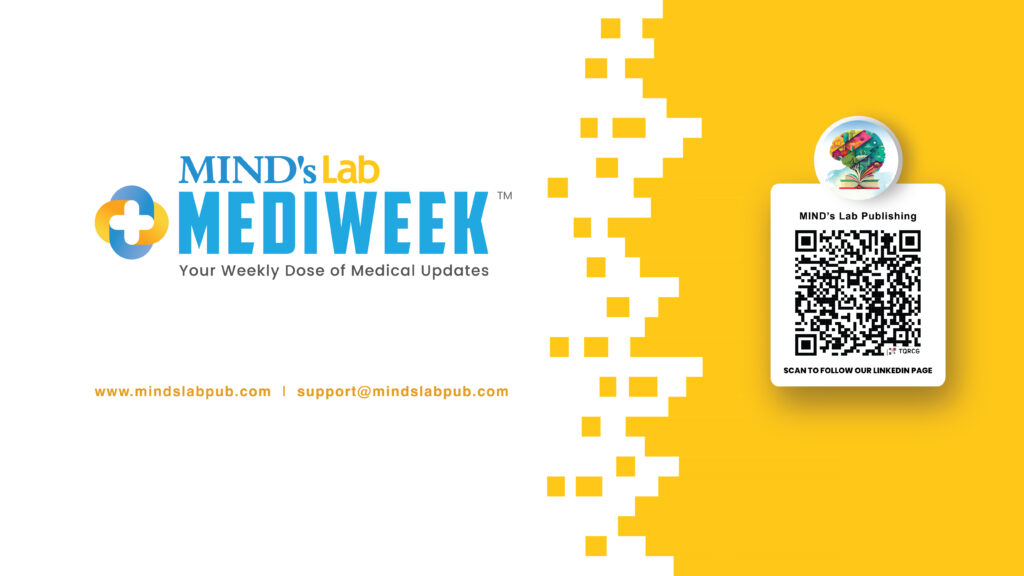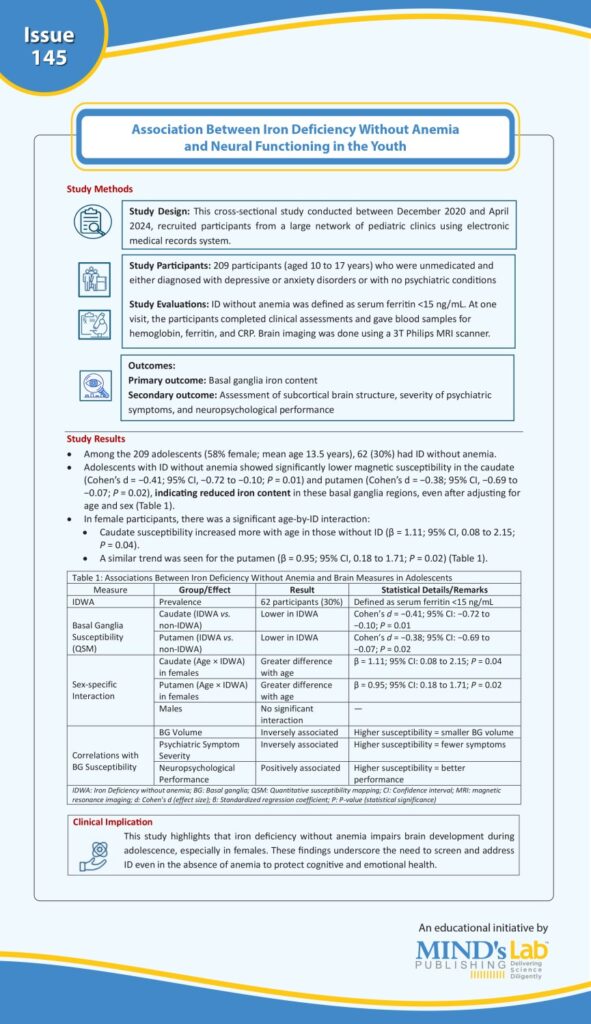
Unseen Deficits: The Neural Impact of Non-Anemic Iron Deficiency in Adolescents
- July 11, 2025
- MIND's Lab Publishing
 Iron deficiency (ID) is the most common nutritional deficiency worldwide. While most efforts target iron deficiency anemia, ID without anemia is also common and carries important health consequences. Traditional diagnostic methods rely heavily on hematologic markers like hemoglobin or bone marrow iron, often overlooking effects of low iron levels on other organs—especially the brain.
Iron deficiency (ID) is the most common nutritional deficiency worldwide. While most efforts target iron deficiency anemia, ID without anemia is also common and carries important health consequences. Traditional diagnostic methods rely heavily on hematologic markers like hemoglobin or bone marrow iron, often overlooking effects of low iron levels on other organs—especially the brain.
Iron is important for brain development, including neurogenesis, myelination, and neurotransmitter production. Even without anemia, low iron levels have been linked to psychiatric issues, sleep disturbances, and cognitive deficits. Yet, the current diagnostic cutoffs often ignore these neurological effects. Recent advances in imaging techniques, particularly quantitative susceptibility mapping (QSM) in magnetic resonance imaging (MRI), allow indirect measurement of brain iron levels. QSM is especially useful for assessing iron in gray matter areas like the basal ganglia, where iron is abundant and vital for function. This opens new pathways for understanding how subclinical iron deficiency may impact brain health in the youth.
A study by Fiani et al., published in the journal “JAMA Network Open”, aimed to investigate the association between iron deficiency (ID) without anemia and basal ganglia (BG) iron content, its structure, and function in adolescents. In this cross-sectional study, 209 unmedicated participants aged 10–17 years (58% female) were enrolled between 2020 and 2024. ID without anemia was defined as serum ferritin <15 ng/mL. MRI was used to assess BG susceptibility and volume, along with psychiatric interviews and cognitive testing. ID without anemia was observed in 62 participants (30%). This group had significantly lower susceptibility in the caudate (d = −0.41; P = 0.01) and putamen (d = −0.38; P = 0.02). Among female subjects, increasing age amplified this difference. Lower BG iron levels were linked to higher psychiatric symptoms and poorer neurocognitive performance. This study outlines the need to consider brain health in the clinical assessment of ID as ID without anemia may negatively impact brain development and function during adolescence (a period of brain development), especially in females (See Graphic).

(Source: Fiani D, Kim JW, Hu M, Salas R, Heilbronner S, Powers J, Haque M, Dinh S, Huang X, Worthy D, Devaraj S. Iron deficiency without anemia and reduced basal ganglia iron content in youths. JAMA Network Open. 2025;8(6):e2516687- Doi:10.1001/jamanetworkopen.2025.16687)

1 Comment
Your comment is awaiting moderation.
a2ba10
Your comment is awaiting moderation.
y5pwep
Your comment is awaiting moderation.
jz0w86
Your comment is awaiting moderation.
https://shorturl.fm/9VnyL
Your comment is awaiting moderation.
https://shorturl.fm/2stkT
Your comment is awaiting moderation.
m7wph8
Your comment is awaiting moderation.
https://shorturl.fm/5k3p8
Your comment is awaiting moderation.
https://shorturl.fm/YJkR7
Your comment is awaiting moderation.
https://shorturl.fm/tKGTC
Your comment is awaiting moderation.
https://shorturl.fm/l2fgb
Your comment is awaiting moderation.
https://shorturl.fm/N542W
Your comment is awaiting moderation.
https://shorturl.fm/o1K6F
Your comment is awaiting moderation.
https://shorturl.fm/6GozN
Your comment is awaiting moderation.
https://shorturl.fm/Je503
Your comment is awaiting moderation.
https://shorturl.fm/NrK81
Your comment is awaiting moderation.
https://shorturl.fm/I15qO
Your comment is awaiting moderation.
https://shorturl.fm/4oBT0
Your comment is awaiting moderation.
https://shorturl.fm/368hd
Your comment is awaiting moderation.
https://shorturl.fm/aE42O
Your comment is awaiting moderation.
https://shorturl.fm/LNaau
Your comment is awaiting moderation.
https://shorturl.fm/mzLy9
Your comment is awaiting moderation.
https://shorturl.fm/Udq5L
Your comment is awaiting moderation.
A very insightful study that highlights the hidden risks of Iron deficiency without anemia. still harm brain development in youth, highlighting the need for early detection and intervention, especially in girls..👍💯
Your comment is awaiting moderation.
https://shorturl.fm/zCAGk
Your comment is awaiting moderation.
https://shorturl.fm/EpeT8
Your comment is awaiting moderation.
https://shorturl.fm/pxLek
Your comment is awaiting moderation.
https://shorturl.fm/FViGH
Your comment is awaiting moderation.
https://shorturl.fm/wfYCI
Your comment is awaiting moderation.
https://shorturl.fm/J7H9G
Your comment is awaiting moderation.
https://shorturl.fm/vhdj6
Your comment is awaiting moderation.
https://shorturl.fm/tOoS8
Your comment is awaiting moderation.
https://shorturl.fm/CTBNB
Your comment is awaiting moderation.
otbxgp
Your comment is awaiting moderation.
https://shorturl.fm/zJrUI
Your comment is awaiting moderation.
https://shorturl.fm/WfFQE
Your comment is awaiting moderation.
6pnonl
Your comment is awaiting moderation.
fnaoy3
vjhvjkvjkhv
Your comment is awaiting moderation.
Gfjsmak